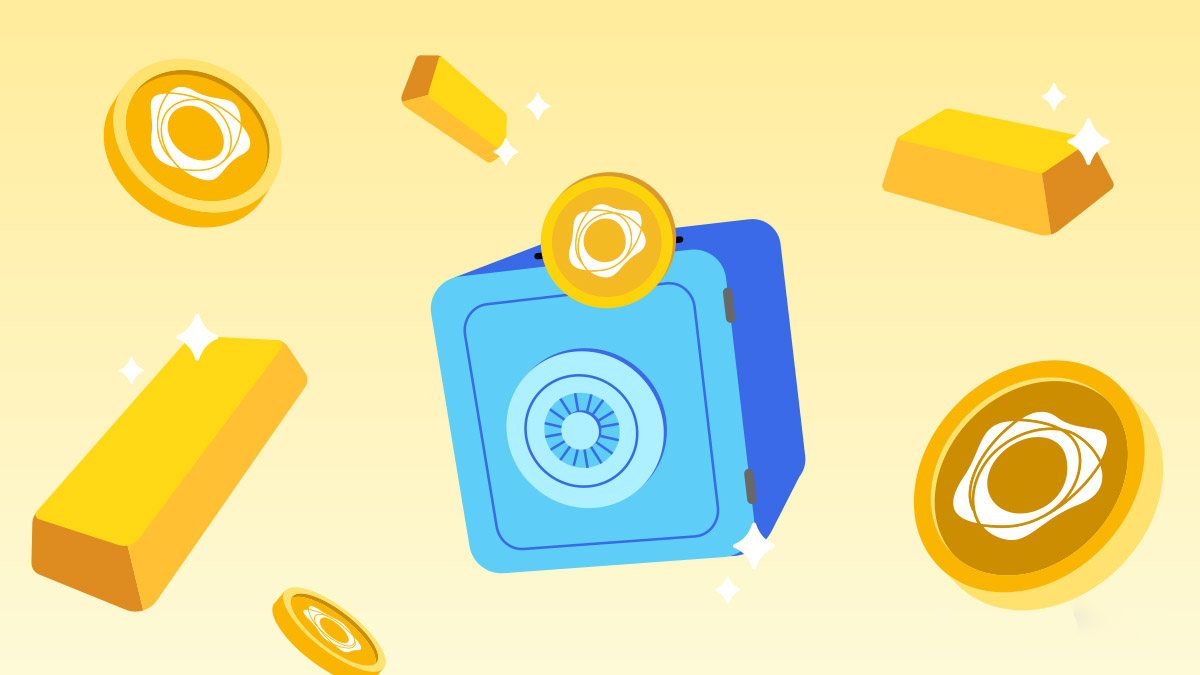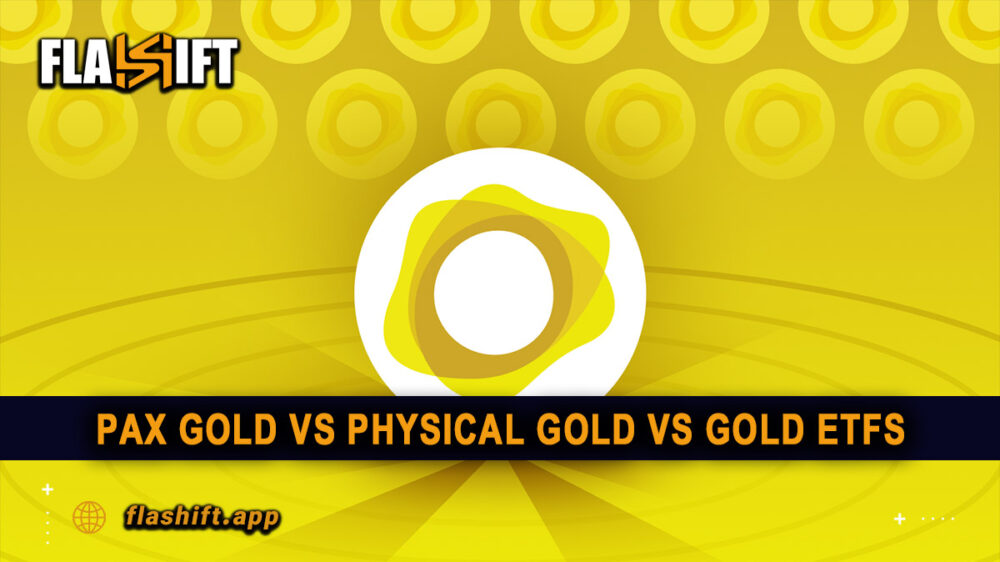PAX Gold vs Physical Gold vs Gold ETFs | In today’s unstable economic climate, investors are turning to gold as a haven asset. But now that innovative crypto tokens like PAX Gold (PAXG) are on the scene, the more interesting question is: What is the best way to invest in gold? Each type of investment has advantages and disadvantages, from physical gold and ETFs to groundbreaking digital tokens like PAXG.
In this post, we’ll simplify the big distinctions between PAX Gold, actual gold, and gold ETFs to help you determine the investment that best suits your goals for 2025 and the years ahead.
What Is the Best Way to Invest in Gold in 2025?
Gold has always remained one of the most trusted assets for preserving wealth. Yet in 2025, investors have never had more alternatives than they have today— physical gold, modern Gold ETFs, and digital tokens like PAX Gold (PAXG). Understanding the differences among these products is key to making the proper investment decision. So, we should know their features first.
What Is PAX Gold (PAXG) and How Does It Work?
PAX Gold (PAXG) is a digital token supported by physical gold. A PAXG token represents fine troy ounces of gold stored in LBMA-approved vaults in London. Manufactured by the Paxos Trust Company, the digital asset provides the stability of physical gold with the ease and liquidity of the cryptocurrency.
With PAXG, investors can own gold allocated without storage, insurance, or transport costs. Since it is on the Ethereum blockchain, PAXG can be purchased and sold on major crypto exchanges immediately and with low transaction fees compared to traditional gold procurement.
For other people seeking access and stability, PAXG is emerging as a modern solution for gold investment in the contemporary period.
Physical Gold Investment Explained: Bars, Coins, and Storage
Physical gold is the oldest and most tangible way to invest in this precious metal. Whether as coins or bars of gold, physical gold offers outright ownership with no counterparty risk. It has been a haven asset for a long time, especially in recession or inflation.
However, physical gold ownership has drawbacks. Investors must consider secure storage, insurance, possible liquidity concerns, and commissions.
What Are Gold ETFs and How Do They Compare to Other Options?
Gold ETFs are a more straightforward way of investing in gold without holding it. They track the price of gold and trade on major exchanges like stocks. Physical reserves of gold back some, and some use derivatives to mimic price movement.
Gold ETFs are liquid, simple to sell and purchase, and have no insurance or storage requirements. However, investors never own the gold and are exposed to custodians and management risks. Even if management fees are fairly low, they can eat up into long-term profits.
In the PAX Gold (PAXG) vs Physical Gold vs Gold ETF comparison, ETFs are flexible and convenient but lack the decentralized ownership of PAXG and the physical possession of physical gold.
Read More: PAX Gold (PAXG) vs Tether Gold (XAUt): Which Tokenized Gold Investment Is Better in 2025?
PAX Gold vs Physical Gold vs Gold ETFs: Key Differences

Ownership Structure: Tokenized Gold vs Physical vs Fund-Based
One of the most significant distinctions in the PAX Gold (PAXG) vs Physical Gold vs Gold ETF comparison is how ownership is structured:
- PAX Gold (PAXG): Each token represents direct ownership of a specific ounce of gold stored in a vault, verifiable on the blockchain. This setup gives investors legal title to the gold, making it more than just a representation of value.
- Physical Gold: Offers full, direct ownership. Investors control their gold completely, whether stored at home or in a vault. However, this also comes with the responsibility of safe storage and insurance.
- Gold ETFs: Investors own shares in a fund, not the actual gold. The fund owns the bullion or uses contracts to mirror gold prices. There’s no direct claim to specific gold holdings.
PAXG and physical gold stand out for investors seeking transparency and control, while ETFs offer more convenience with indirect exposure.
Liquidity Comparison: Trading PAXG, Selling Physical Gold, and Exiting ETFs
Liquidity matters when you need quick access to your funds. Here’s how each option compares:
- PAX Gold (PAXG): Highly liquid and tradable 24/7 on cryptocurrency exchanges. PAXG offers fast settlement and global accessibility, making it ideal for those who prioritize speed and flexibility.
- Physical Gold: Selling physical gold can be time-consuming and less efficient. It may require visiting a dealer, negotiating prices, and dealing with variable buy-back premiums.
- Gold ETFs: Traded on stock exchanges during market hours, ETFs provide good liquidity. However, they are subject to market hours, brokerage fees, and potential price slippage.
Regarding liquidity, PAXG and ETFs outperform physical gold, though PAXG has the added benefit of round-the-clock trading.
Transparency and Custody: Blockchain vs Vault vs Fund Manager
When it comes to knowing exactly where your gold is and who’s managing it, transparency and custody become key differentiators:
- PAX Gold (PAXG) uses blockchain to provide real-time proof of reserves and ownership. All tokens are backed by gold and held in fully audited, LBMA-approved vaults, offering high transparency.
- Physical Gold: You know exactly where your gold is—because you hold or store it privately. However, if stored externally, trust in custodians becomes essential.
- Gold ETFs are managed by financial institutions or fund managers. While reputable, the transparency of actual gold backing and exact holdings may vary by fund. Investors must rely on quarterly or annual reports.
PAXG provides an innovative middle ground—offering verifiable ownership without the hands-on logistics of physical gold. So, it’s critical to know how to buy PAX Gold in 2025.
Fees and Hidden Costs in Gold Investments
Understanding the cost of your investment is crucial, especially over the long term. Here’s how the fees break down:
- PAX Gold (PAXG): Low custody and transaction fees. There’s no storage fee for holders (Paxos manages custody), though you may pay gas fees and trading commissions on exchanges.
- Physical Gold: Costs include dealer premiums, storage (vault or safe), insurance, and sometimes shipping. Selling costs can also be higher due to spread differences.
- Gold ETFs typically have low annual management fees (usually between 0.25% and 0.50%), but investors may also pay brokerage fees and bid/ask spreads.
While ETFs appear cost-effective, hidden management fees and a lack of ownership may be concerns. PAXG offers a more balanced fee structure with high transparency and control.
Pros and Cons Comparison Table
| Feature / Type | PAX Gold (PAXG) | Physical Gold | Gold ETFs |
| Ownership | ✅ Direct ownership via blockchain token | ✅ Full physical ownership | ❌ Indirect—ownership of fund shares |
| Liquidity | ✅ High (24/7 crypto trading) | ❌ Low (requires dealers or buyers) | ✅ High (during market hours) |
| Transparency | ✅ Blockchain-based, real-time proof | ✅ Full visibility if self-stored | ❌ Limited to fund reports |
| Storage & Custody | ✅ Vaulted by Paxos—no storage needed for users | ❌ Requires secure storage and insurance | ✅ Custodied by fund managers |
| Ease of Access | ⚠️ Requires crypto knowledge and wallet setup | ❌ Less convenient, especially for small investments | ✅ Easy via brokerage accounts |
| Fees | ✅ Low (no storage fees, minimal trading costs) | ❌ High (dealer premiums, storage, insurance) | ⚠️ Moderate (management fees, brokerage costs) |
| Security Risks | ⚠️ Digital risks (hacking, wallet loss) | ❌ Physical risks (theft, damage) | ⚠️ Fund manager and custodian risk |
| Regulatory Clarity | ❌ Evolving crypto regulations | ✅ Well-established | ✅ Regulated financial product |
| Best For | Tech-savvy investors wanting digital gold ownership | Long-term holders who value tangible assets | Traditional investors seeking market-traded gold exposure |
Which Type of Gold Investment Is Best for You?

Choosing PAX GolAd (PAXG), physical gold, or gold ETFs is determined by your objectives, preferences, and level of involvement in investment management.
For investors who require instant ownership of physical gold with the ease of digital trading, PAXG finds a perfect balance of security, transparency, and 24/7 liquidity. It best suits investors with experience working with crypto platforms and value decentralized finance.
Physical gold appeals to those who like to hold and control tangible assets. Although it requires safe storage and is less liquid, it’s a secure way to protect long-term wealth and gives a sense of security in times of economic uncertainty.
Gold ETFs, however, offer the most straightforward and most convenient option. They enable exposure to gold prices without needing physical or digital asset handling. With ready access via brokerage accounts and modest fees, ETFs are suitable for investors who prefer simplicity and market integration to outright ownership.
To decide what’s right for you, consider the following:
- Do you prefer full control or ease of use?
- Are you looking for 24/7 liquidity or is market-hour access sufficient?
- Would you rather hold real gold or invest in a gold-tracking asset?
There’s no universal winner in the PAX Gold (PAXG) vs Physical Gold vs Gold ETF comparison. Each has its place in a well-rounded portfolio. Depending on your risk tolerance and strategy, you may benefit from combining all three.
Conclusion
The optimal gold investment is based on your objectives and preferences. PAXG provides digital ownership with liquidity and transparency, which is best suited for technologically oriented investors. Physical gold provides tangible security and long-term wealth protection, albeit with more management. Gold ETFs are a simple, traditional means of investing in gold, providing simplicity and liquidity. A diversified strategy utilizing all three may provide your investment plan’s optimal balance of security, flexibility, and convenience.
FAQ
- Can I access my PAXG at any time?
Yes, PAXG can be traded 24/7 on various crypto exchanges, allowing you instant access to your investment. - How does the value of PAXG compare to physical gold?
PAXG’s value is directly tied to the price of physical gold, as each token represents one ounce of gold held in reserve. However, PAXG allows for quicker trading and lower fees. - What are the main risks of investing in physical gold?
The main risks include storage costs, the potential for theft, and the lack of liquidity compared to digital or ETF options. - Are there any hidden fees with Gold ETFs?
Gold ETFs typically have management fees and may also incur trading commissions, though these are generally lower than the costs associated with physical gold storage. - Can I use PAXG for daily transactions like cash?
While PAXG is a digital asset, it is not widely accepted for everyday purchases like cash. Its main use is as an investment or store of value rather than for daily transactions.







